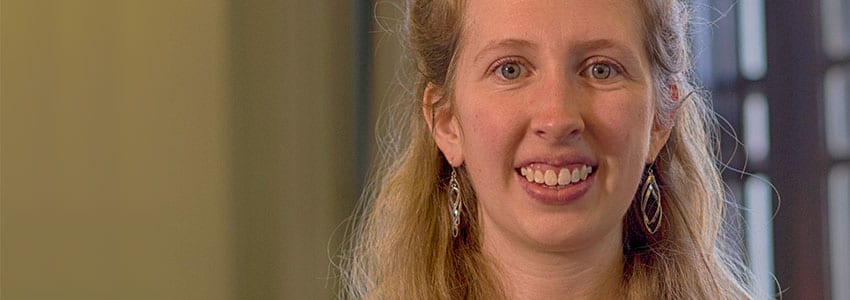After finishing her undergraduate degree in neuroscience at Scripps College, Katie worked in a neuroscience lab at Stanford for a few years. She recalls, “I developed my own ideas of what I wanted to do. I knew as I entered graduate school I needed faculty who would give me a lot of autonomy in my science. My idea for my research was to combine human neuroimaging data with data from rodent models to further understand how the brain develops anxiety disorders and how we can better treat them. To make this happen, I needed to be able to work with both humans and animals. When I was choosing graduate schools six years ago, it wasn’t common to find a single lab that did both. I was looking for a place where faculty members were interested and willing to collaborate with each other and with me to do this project. I found that at Michigan.”
As a sixth year doctoral candidate, Katie is focused on research to understand how we can better predict who may or may not develop post-traumatic stress disorder (PTSD) after trauma. She originally fell into place at UM with two faculty mentors, but her graduate school trajectory was thrown off balance when they both left the university. She had the opportunity to go with either one of them but saw more opportunities to stay at UM. With her new mentor, she’s now looking at temperament, or personality, in rodents seeking connections between individuals’ temperament and anxiety, and how that plays out in the brain.
The next step in her research is to convince the rest of field that they should pay more attention to individual differences in rodents, to understand a new model of therapy, and to eventually apply that knowledge back to humans. Her hope is to better understand the potential for how individual differences shape fear learning and reduction. She says, “There are ways to help individuals who seem more vulnerable to reduce their fear after trauma exposure. If the differences we see in rodent models translate to humans, we can develop screening procedures for at-risk individuals before they experience trauma.” She is now looking in the brain to determine if different circuitry patterns emerge from individuals who are or are not vulnerable. She explains, “I’m interested to see if the patterns we see in rodents look similar to the patterns we see in our anxiety patients.”
For fun, Katie relaxes by playing board games with her husband and their friends. However, she doesn’t have much free time outside of lab and organizing RELATE (www.learntoRELATE.org), a program to train scientists to communicate effectively with lay audiences. Katie says, “I co-founded RELATE, and that means on top of lab work we are essentially working a second full-time job. This summer, we’ve organized a ten-week workshop for 36 grad students from 15 different graduate programs. “
RELATE is a program born out of need. Katie and co-founder Elyse Aurbach both wanted further training in communication skills but there weren’t a lot of resources for graduate student scientists beyond brief, one-hour workshops. She says, “We sought out a class because we wanted to take it. Since it wasn’t offered, we thought we’d design it.” She and Elyse won an NSF Innovation in Graduate Education Challenge Community Choice Award with the help of many students, faculty, and friends at UM. Rackham’s Dean Weiss heard of the proposal and connected Katie and Elyse with Paula Wishart, who leads professional development at Rackham. Together with Dr. Leah Bricker, a faculty member in the School of Education, they developed a workshop curriculum and successfully piloted the program last year with 29 grad students in an eight-week workshop. She says, “Leading RELATE has been exhausting sometimes, but definitely worth it. It has been a really fantastic experience, and I could not have done it without Rackham support.” Katie says, “There is a clear interest and need. Over 150 students came to the information session for this year’s RELATE workshop. Students in other programs are asking when we’ll have workshops for them too.”
Moving forward, Katie is looking at staff scientist or postdoctoral positions that would allow her to spend around 20% of her time on science communication work. As she switches universities, she’s hoping to make the first RELATE satellite program. She says, “I’m looking at this as a potential career option in the future. I really love this work.”

